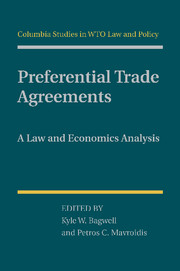Book contents
- Frontmatter
- Contents
- Contributors
- Introduction: The Law and Economics of Contingent Protection
- 1 Preferential Trading Agreements: Friend or Foe?
- The “Legalization” of GATT Article XXIV – Can Foes Become Friends?
- 2 Third-Country Effects of Regional Trade Agreements
- 3 Contingent Protection Rules in Regional Trade Agreements
- 3.1 Commentary on “Contingent Protection Rules in Regional Trade Agreements”
- 4 The Limits of PTAs
- 5 EU and U.S. Preferential Trade Agreements: Deepening or Widening of WTO Commitments
- Straightening the Spaghetti Bowl
- 5.1 Comments on “Beyond the WTO? Coverage and Legal Inflation in EU and U.S. Preferential Trade Agreements”
- 6 Labor Clauses in EU Preferential Trade Agreements – An Analysis of the Cotonou Partnership Agreement
- 7 Do PTAs Actually Increase Parties' Services Trade?
- 8 A Model Article XXIV: Are There Realistic Possibilities to Improve It?
- 8.1 Comments on “A Model Article XXIV: Are There Realistic Possibilities to Improve It?”
- Index
- References
3 - Contingent Protection Rules in Regional Trade Agreements
Published online by Cambridge University Press: 03 May 2011
- Frontmatter
- Contents
- Contributors
- Introduction: The Law and Economics of Contingent Protection
- 1 Preferential Trading Agreements: Friend or Foe?
- The “Legalization” of GATT Article XXIV – Can Foes Become Friends?
- 2 Third-Country Effects of Regional Trade Agreements
- 3 Contingent Protection Rules in Regional Trade Agreements
- 3.1 Commentary on “Contingent Protection Rules in Regional Trade Agreements”
- 4 The Limits of PTAs
- 5 EU and U.S. Preferential Trade Agreements: Deepening or Widening of WTO Commitments
- Straightening the Spaghetti Bowl
- 5.1 Comments on “Beyond the WTO? Coverage and Legal Inflation in EU and U.S. Preferential Trade Agreements”
- 6 Labor Clauses in EU Preferential Trade Agreements – An Analysis of the Cotonou Partnership Agreement
- 7 Do PTAs Actually Increase Parties' Services Trade?
- 8 A Model Article XXIV: Are There Realistic Possibilities to Improve It?
- 8.1 Comments on “A Model Article XXIV: Are There Realistic Possibilities to Improve It?”
- Index
- References
Summary
Introduction
This chapter examines contingent protection provisions in seventy-four regional trade agreements (RTAs). Before we discuss any motivation or results, we will make two comments on our terminology. First, we use the term “regional trade agreements” in a broad sense. For purposes of this chapter we use the term to refer to customs unions (where tariffs are zero for intra-RTA trade and are set at a common level for external trade), free trade areas (where tariffs are zero for intra-RTA trade and each member is free to set its own tariffs for external trade), and preferential trade agreements (where tariffs are lowered but not necessarily zero for intra-RTA trade and each member is free to set its own tariffs for external trade). Whether member-states are in the same regional or geographical area does not matter for our purposes. As RTAs have proliferated many, perhaps even most, RTAs involve countries in geographically distinct areas.
Second, by “contingent” protection we mean antidumping (AD), countervailing duties (CVD), and emergency or safeguard measures. Because the World Trade Organization (WTO) agreement requires a link between trade volume and the imposition of trade protection for all of these trade remedies, they are referred to as contingent protection. Although other forms of protection often garner more attention (e.g., Super 301, TRIPs), the statutes mapped in this chapter account for most of the discretionary border protection beyond WTO-negotiated tariff rates.
- Type
- Chapter
- Information
- Preferential Trade AgreementsA Law and Economics Analysis, pp. 60 - 100Publisher: Cambridge University PressPrint publication year: 2011
References
- 4
- Cited by

